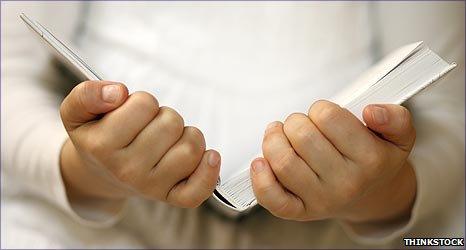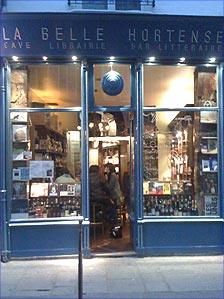Is our relationship with books changing?
- Published

Books are a pleasure on so many different levels, but is how we consume them changing, asks Lisa Jardine in her A Point of View column.
It seems that almost two thirds of us did not visit a public library last year. The culture minister has suggested that numbers of book borrowers might be higher if libraries were moved from purpose-built locations staffed by qualified librarians to supermarkets and public houses, manned by volunteers. Book borrowers are understandably alarmed.
Not that the prospect is necessarily quite as grim as some might think. I am old enough dimly to remember taking my parents' library card into Boots the Chemist, which ran a popular lending library when I was a child (there was a small charge for membership).
In fact, I can remember an occasion when I stood for some time at the counter while two assistants whispered together to decide whether the large tome with a picture of two bosomy ladies of the 16th Century French court, in low-cut dresses, on the cover, was suitable for a child to borrow.
And passing through Paris at the end of August, I stood watching drinkers and readers rubbing shoulders in La Belle Hortense - an obviously extremely popular bar in the Marais district, whose shop-front advertises it to be a combined cafe, bar and bookshop.
The sign in the window says you are welcome to read the books in stock while you drink, with no obligation to purchase. If public libraries fall victim to this autumn's government austerity measures, as some are warning, perhaps we will have to reconsider these other kinds of model for bringing books to readers.
Because there certainly still are lots of enthusiastic consumers of serious books among us. In spite of press scepticism in advance of the launch, large numbers of us have bought a copy of former Prime Minister Tony Blair's autobiography, A Journey, which was published last week (I confess I am one of them).
Heavily discounted by bookshops and online retailers, the book could be yours for little more than the price of two gallons of petrol. Blair's Journey has already sold more than 100,000 copies, and gone through six reprintings. It is likely to stay at the top of the best-seller list for weeks.
Phenomenon
Might it be that those who love to read, and who used to make the weekly trip to their local public library, nowadays prefer to hold on to what they have read? Book buying has enjoyed something of a renaissance over the past 20 years, and new kinds of booksellers, including online retailers and supermarkets, have successfully brought serious books to the attention of new kinds of readers.
The extraordinary success of the Harry Potter stories with adults and children alike is a much-cited example, but there have been other initiatives to extend the reach of hardback fiction in particular, both in Britain and the United States.
In the course of a discussion on her TV show in the late 1990s, the American daytime talk-show host Oprah Winfrey happened to mention the title of a novel she was enjoying reading. Unexpectedly large numbers of her audience immediately rushed out and bought it.

The shop sells books and drinks
The book, The Deep End of the Ocean, by Jacqueline Mitchard, an almost unknown fiction writer, told the intense, emotional story of a woman whose three-year-old child disappears from a hotel lobby while her back is turned. Within days The Deep End of the Ocean had gone to the top of the American best-seller list, where it remained for six consecutive weeks, eventually selling more than eight million copies.
Oprah was hailed as a marketing phenomenon by the American publishing industry. That was the start of her long-running and much imitated Book Club, which for 15 years has guided the book-buying habits of a previously untapped section of the American reading public.
The success of the book club encouraged Oprah to be characteristically ambitious on behalf of her readers. Within months she had progressed from recommending books whose stories readers could straightforwardly identify with, to high-quality fiction by established contemporary writers, like Marquez's One Hundred Years of Solitude, as well as great classic novels like Tolstoy's Anna Karenina. She picked Maya Angelou's The Heart of a Woman and Carson McCullers' The Heart is a Lonely Hunter.
When her choice of the month was Paradise, a brand new, rather difficult novel by Nobel Prize winner Toni Morrison, Oprah's show featured an extended seminar with the author, conducted from her study at Princeton University with members of her TV audience, chosen by ballot, as the participants.
Crowning glory
Oprah took care to enlist the expert advice of specialist critics to shape her book choices and inform the dialogue she conducted with her audience - her readers - on her show.
I am convinced that her guided course in reading really did help produce a new cohort of self-educated American readers, who had the confidence and enthusiasm to tackle both classics and critically acclaimed high-brow modern fiction.
In the course of Oprah's animated dialogue on - and off - screen with her audience, as she promoted the reading of serious and challenging books by those who were not accustomed to reading for pleasure at all, she discovered that they not only wanted to own the books they read, they wanted to keep them, and sometimes to pass them to others as treasured gifts.
And if books were to take pride of place in their living room, they really wanted them to be properly bound, in good-looking hard covers.
One of the early titles she recommended, from the back list of a well-known author, was only available in paperback. Oprah expressed the view strongly on her show that the work ought to be made available in an inexpensive hardback, since that was what her audience wanted - a book to keep.
The publisher responded with an entire new hardback printing, at an affordable, heavily subsidised cover price (by then it was clear that here was a guaranteed sale of millions of copies).
The preference of Oprah's audience for books in hardback harks back to earlier days in the history of reading. A book's binding used to be its crowning glory. The dust-jacket on which modern publishers lavish such pains was originally designed to protect the leather binding, with its stamped and tooled decoration and gilded lettering.
Handsome
In the 15th Century Islamic bindings were particularly elaborate and gorgeous, and some of the patterns used on European bindings down to the 20th Century still carry echoes of designs first used on the covers of early Korans.
As a child, the texture of the covers of the volumes of Arthur Mee's Children's Encyclopaedia gave me almost as much pleasure as the content. Today, publishers still produce attractive special editions of important books, in their own elegant slip-covers - as indeed have the publishers of the Blair autobiography.
But if the cover has been an intrinsic part of serious books for so long, and readers find paperbacks less satisfying, what does that tell us about the enjoyment we will find in e-books? Is it bound to be less satisfying for the reader if what they read is delivered in uniform text format, without cover or illustrations?

Winfrey's book club has run for 15 years
At the beginning of this year I expressed the view here that I would always consider an electronic book a poor substitute for the real thing. Handling a book, enjoying the design, the binding and the illustrations, perhaps annotating its pages with my own responses to what I am reading, are, for me, and always will be, I said, a crucial part of the enjoyment of a good book.
Well, as so often in my life, I have had to reconsider. For everyday purposes I now find my electronic reader allows me to pursue a book I am enjoying wherever I go. I have to confess that I am reading Tony Blair's autobiography, purchased from my favourite online bookseller, on my iPad. Having spent much of the past week in airports and on planes, there is little doubt in my mind that this is far and away the most convenient way to read.
And even now that I am settled back at home after my wanderings, I won't, I am afraid, be purchasing a conventional copy, even though I know that in addition to there being no glossy cover, my copy is missing the accompanying, never seen before, Blair family photographs (as I noted when I looked over the shoulder of my neighbour, reading more conventionally, on a plane from Berlin to Rome).
I won't even be tempted by a special copy, in a red cloth slip cover, with handsome gold lettering, signed by the author.